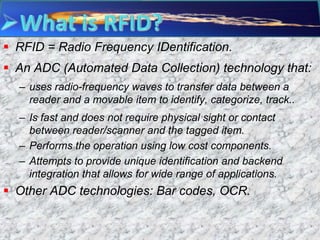
What is rfid
- 1. RFID = Radio Frequency IDentification. An ADC (Automated Data Collection) technology that: – uses radio-frequency waves to transfer data between a reader and a movable item to identify, categorize, track.. – Is fast and does not require physical sight or contact between reader/scanner and the tagged item. – Performs the operation using low cost components. – Attempts to provide unique identification and backend integration that allows for wide range of applications. Other ADC technologies: Bar codes, OCR.
- 2. RFID system components Ethernet RFID Reader RFID Tag RF Antenna Network Workstation
- 3. RFID tags: Smart labels A paper label with RFID inside an antenna, printed, etched or stamped ... … and a chip … on a substrate attached to it e.g. a plastic foil ...
- 5. RFID tags Tags can be attached to almost anything: Items, cases or pallets of products, high value goods vehicles, assets, livestock or personnel Passive Tags Do not require power – Draws from Interrogator Field Lower storage capacities (few bits to 1 KB) Shorter read ranges (4 inches to 15 feet) Usually Write-Once-Read-Many/Read-Only tags Cost around 25 cents to few dollars Active Tags Battery powered Higher storage capacities (512 KB) Longer read range (300 feet) Typically can be re-written by RF Interrogators Cost around 50 to 250 dollars
- 6. Tag block diagram Antenna Power Supply Memory Control Logic Cells Tx Modulator (Finite State machine) Rx Demodulator Tag Integrated Circuit (IC)
- 7. RFID tag memory Read-only tags Tag ID is assigned at the factory during manufacturing Can never be changed No additional data can be assigned to the tag Write once, read many (WORM) tags Data written once, e.g., during packing or manufacturing Tag is locked once data is written Similar to a compact disc or DVD Read/Write Tag data can be changed over time Part or all of the data section can be locked
- 8. RFID readers Reader functions: Remotely power tags Establish a bidirectional data link Inventory tags, filter results Communicate with networked server(s) Can read 100-300 tags per second Readers (interrogators) can be at a fixed point such as Entrance/exit Point of sale Readers can also be mobile/hand-held
- 9. Smart groceries Add an RFID tag to all items in the grocery. As the cart leaves the store, it passes through an RFID transceiver. The cart is rung up in seconds.
- 10. RFID advantages over bar-codes No line of sight required for reading Multiple items can be read with a single scan Each tag can carry a lot of data (read/write) Individual items identified and not just the category Passive tags have a virtually unlimited lifetime Active tags can be read from great distances Can be combined with barcode technology
- 11. Host manages Reader(s) and issues Commands Reader and tag communicate via RF signal Carrier signal generated by the reader Carrier signal sent out through the antennas Carrier signal hits tag(s) Tag receives and modifies carrier signal – “sends back” modulated signal (Passive Backscatter – also referred to as “field disturbance device”) Antennas receive the modulated signal and send them to the Reader Reader decodes the data Results returned to the host application
- 12. Antenna fields: Inductive coupling IC or microprocessor Transceiver RFID Tag Reader Tag antenna antenna
- 13. Antenna fields: Propagation coupling Transceiver RFID Tag Reader Tag antenna antenna
- 14. Reader Collision Problem Reader-Reader Interference Reader-Tag Interference
- 15. Reader Collision and Hidden Terminal The passive tags are not able to take part in the collision resolution or avoidance, as in other wireless systems Consider: RTS-CTS for hidden terminal problem in 802.11 rfid: T is not able to send a CTS in response to an RTS from R In case multiple readers try to read the same tag, the tag cannot respond selectively to a particular reader
- 16. TDMA based solution Assign different time slots and/or frequencies to nearby readers Reduces to graph coloring problem (readers form vertices) Only reader to reader interference Assign different operating frequencies Only multiple reader to tag interference Assign different time slots for operation Both types of interference First allot different time slots, then frequencies
- 17. Beacon based solution A reader while reading tag, periodically sends a beacon on the control channel Assumptions Separate control channel between readers The range in the control channel is sufficient for a reader to communicate with all the possible readers that might interfere in the data channel
- 18. Multiple Tags When multiple tags are in range of the reader: All the tags will be excited at the same time. Makes it very difficult to distinguish between the tags. Collision avoidance mechanisms: Probabilistic: Tags return at random times. Deterministic: Reader searches for specific tags.
- 19. Tag Collision Problem Multiple tags simultaneously respond to query Results in collision at the reader Several approaches Tree algorithm Memoryless protocol Contactless protocol I-code protocol
- 20. RFID Summary Strengths Advanced technology Easy to use High memory capacity Small size Weaknesses Lack of industry and application standards High cost per unit and high RFID system integration costs Weak market understanding of the benefits of RFID technology Opportunities Could replace the bar code End-user demand for RFID systems is increasing Huge market potential in many businesses Threats Ethical threats concerning privacy life Highly fragmented competitive environment
- 21. Some Links http://www.epcglobalinc.com/ http://www.rfidjournal.com/ http://rfidprivacy.com/ http://www.rfidinc.com/ http://www.buyrfid.com/ Thank You